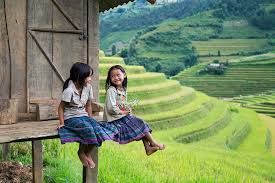
Ethnic Minorities in Vietnam
Table of contents
Ethnic minorities groups in Vietnam
At the crossroads of several cultures and civilizations, point of confluence for multiple ethnic minorities, Vietnam is a multi-ethnic and multi-confessional country. Each group having its own habits, customs and sometimes its own language and script. Quick overview.

An ethnocultural mosaic that dates back to the dawn of time
Born from the interaction of two very ancient civilizations – Chinese and Indian. Then colored by multiple cultural influences and many ethnolinguistic currents over the centuries, Vietnam is a complex and fascinating mosaic of languages, communities and cultures. . This remarkable diversity is reflected in the different ethnic groups that make up the Vietnamese people, both singular and plural.
To facilitate understanding of diversity, researchers and linguists have grouped ethnic groups according to their language. It must be admitted that their jargon is mainly addressed to them. And that ordinary mortals find it difficult to see who the ethnic groups of Austronesian languages or Sino-Tibetan languages and even less Hmong-Mien languages really are.
Here we will just say that Vietnam is a palette of 54 shades, or ethnicities. And we will recognize them first by their costumes with clearly identifiable cuts and colors.

Majority population and ethnic minorities
If there is what is commonly called “ethnic minority”, it is because there is a majority. With approximately 85% of the population, the Kinh – or Viet – represent this majority. Born of immigration and successive conquests, this group seems to have always been there. They settled in the plains and on the coasts or in the northern and southern deltas (Red River and Mekong). Our earlier linguists call them Proto-Indochinese, Stieng , Mnong or Jarai . They formed powerful ethnic groups, reinforced by alliances of circumstance.
Ethnic minorities, on the other hand, are mostly born of the Chinese diaspora. Fleeing famines and/or conflicts, they seize any opportunity for labor or trade. Establishing themselves in the less hospitable regions of the Land of the Dragon. One thinks in particular of the Lolo of North-East Vietnam. But the traveler will also come across the most numerous ethnic groups in Tonkin and Upper Tonkin – namely Tay, Muong, Hmong or even Dao and Nung. It is interesting to note that if ethnic minorities only represent 15% of the total population of Vietnam, their density reaches 30% to 40% in the North of the country. To approach 80% in the provinces of Cao Bang, Hà Giang , Lai Châu and Son La (at the border gates with China, therefore).
We can no longer really speak of a minority… Most of them are descendants of immigrants. They left China as early as the 18th century , or even earlier for some. Each ethnic group can include one or more sub-groups. We will recognize them (with a little experience, for some) by their traditional costumes. Each ethnic family has its costume cut, color and patterns, associated with specific jewelry and hairstyles . The habitats and customs of each other are not the same either.

In the Center:
It is another large area of distribution of ethnic minorities. The ethnic communities will be represented in force on the Hauts-Plateaux. These are the Ede, Jarai and Bahnar, with spectacular communal houses. Fiercely preserved beliefs and customs mark the life of these communities a little apart, strongly impregnated with magic and beliefs. On the side of the coastal plain, between Nha Trang and Mui Ne, you will come across Cham people – of the Muslim faith. Ultimate descendants of a civilization that has now disappeared. And finally, in the Mekong delta, it is the Khmer Krom who represent a minority of more than a million members, all the same. This Khmer presence can be seen mainly in the architecture of the pagodas, a reflection of Buddhism belonging to the Theravada current.
To end this quick summary of the ethnic communities of Vietnam, know that it is the Tay who are the most numerous with more than 1,600,000 members. And that one of the least numerous ethnic groups is that of the O’du with its 340 members living in the lost mountains of Nghe An Province. Their language is only spoken by barely 5 people over 75 who cannot read or write it…
During your next trip to Vietnam, do not hesitate to visit the Museum of Ethnography in Hanoi. In a huge space divided into 3 zones, one of which is outdoors, all ethnic groups are represented here, with many clear and fun explanations about each. Outside, some of the most iconic houses have been rebuilt, for total immersion (and fun for the kids). A must for anyone who wants to understand the richness and complexity of the peoples of Vietnam!
the full list of the ethnic minorities in Vietnam.
Crédits photos : Rainforest Cruises



